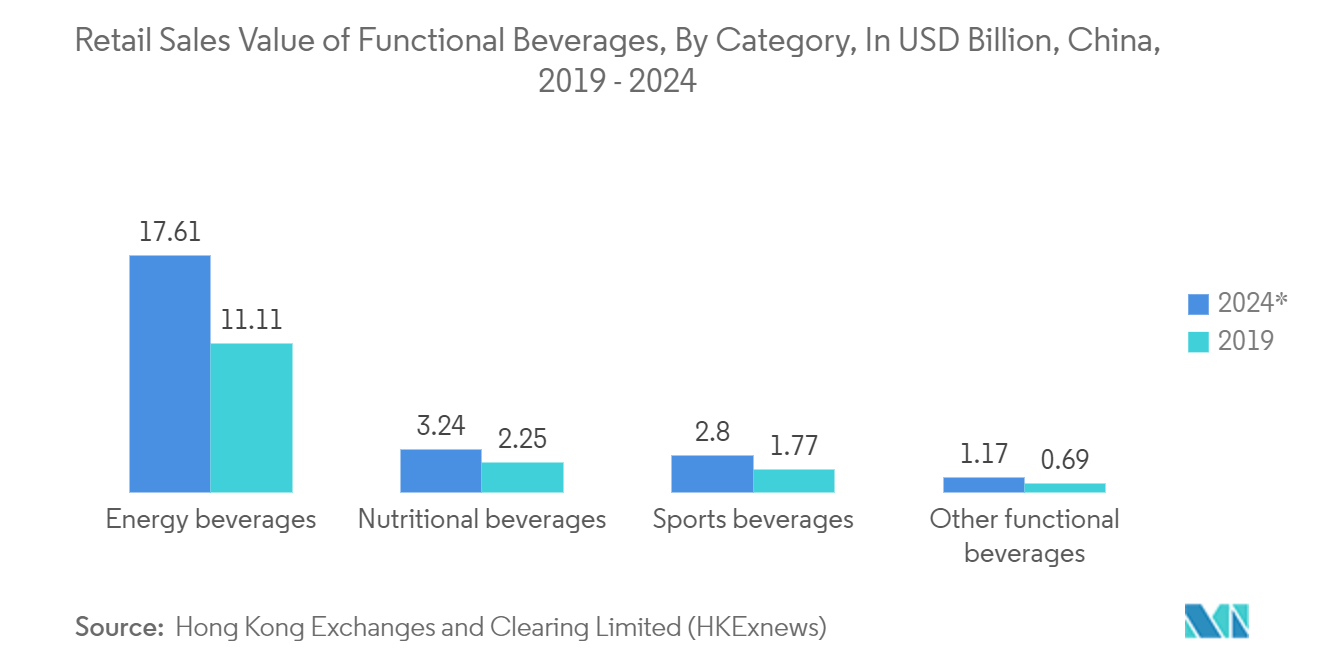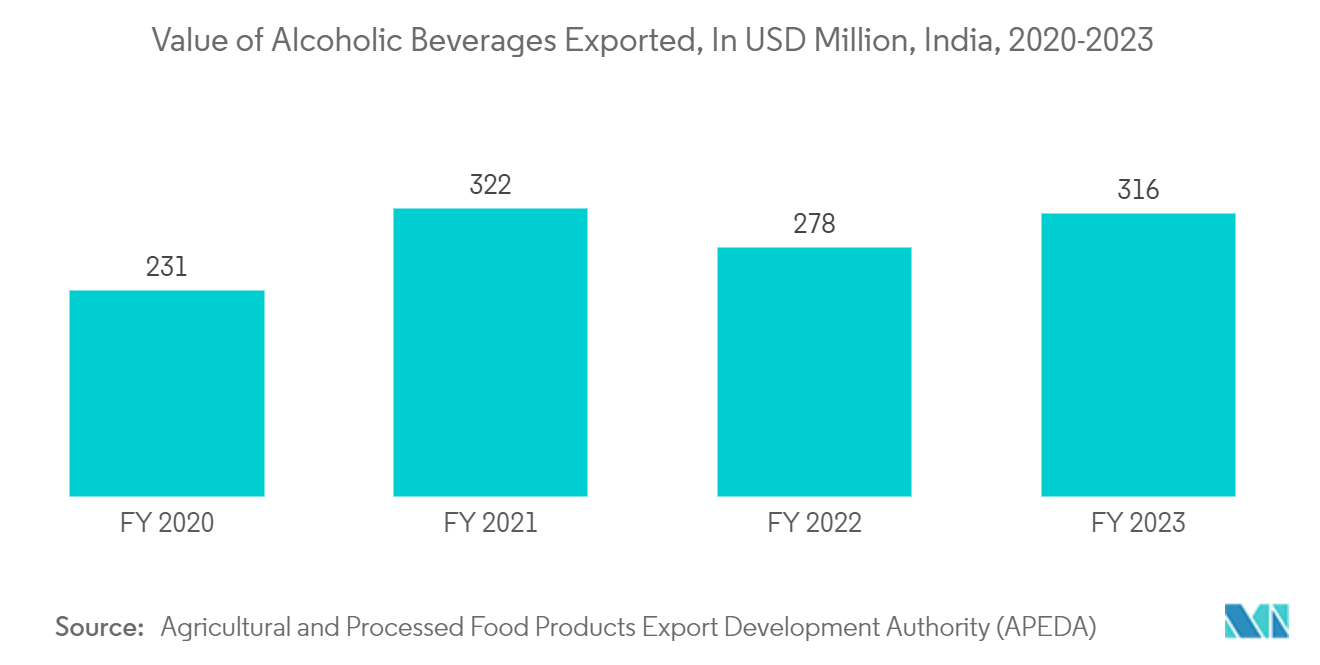Market Trends of Asia-Pacific Glass Bottles And Containers Industry
Beverages are Driving the Sales of Glass Bottles
- The resurgence of Japanese beer sales in South Korea after a diplomatic row five years ago reflects improved relations and effective marketing strategies. Despite a period of decline due to strained ties, imports soared to USD 55.5 million in 2023, up from USD 14.5 million in 2022, signaling a recovery. Brands like Asahi and Kirin capitalized on South Korea's interest in international beverages and Japanese cuisine.
- Furthermore, this turnaround underscores the influence of diplomatic relations on consumer behavior and the importance of strategic marketing in capturing market share. Japanese beer brands successfully navigated past challenges to reclaim dominance in the South Korean imported beer market, marking a notable shift in consumer preferences.
- Korean drinking culture encompasses not only the consumption of alcohol but also the food traditionally served alongside it. Korean cuisine is renowned for its intense and spicy flavors, with many dishes designed to be consumed with alcohol. From classic rice wines to the increasingly popular soju, alcohol is fundamental to Korean society and culture. The market is primarily dominated by low-priced brands that produce soju for the consumption of the general population.
- Additionally, banning single-use plastic has increased the demand for substitute products such as glass. According to the Japan Containers and Packaging Recycling Association, in 2023, the unit cost of recycling amber and colorless glass bottle packaging was the lowest among other packaging at around JPY 8.2 (USD 0.054) and JPY 6 (USD 0.040) per kilogram, which caused players to switch to glass packaging.
- Moreover, since glass is sustainable, infinitely recyclable, reusable, refillable, and inert with no synthetic chemicals, it is safe to store food and drinks. Such properties make it a viable option in packaging beverages. Furthermore, Coca-Cola Japan has implemented various initiatives to create more sustainable products, including removing plastic labels from drinks and reducing power consumption from vending machines. This initiative follows the company's announcement to recycle 25% of packaging worldwide by 2030 and implement reusable packaging, which includes reusable glass bottles and other products. This initiative leverages the glass container market in the region.
- The growing awareness of health and wellness among consumers is driving the demand for functional beverages, which are perceived to offer various health benefits. Glass packaging aligns well with this trend as it is considered a safe and hygienic option for preserving the nutritional integrity of beverages, thus contributing to the growth of the glass bottles and containers market.
- Furthermore, according to Hong Kong Exchanges and Clearing Limited, in 2019, the retail sales of functional beverages in China reached nearly USD 15.82 billion. They are projected to reach USD 24.82 billion in 2024.

India is Driving Toward Growth in the Glass Bottles and Containers Market
- The demand for hard seltzers is rising among the millennials and Gen Z as they are marketed as a healthier and more flavorful alternative to other alcoholic beverages. Hard seltzer has about a third fewer calories and little to no carbohydrates when compared with beer. Seltzers are marketed as low-calorie, low-sugar alternatives to beer and other beverages. In the United States, this new type of alcoholic beverage is rapidly transforming the drinking habits of Americans.
- Furthermore, various soft drink manufacturers run campaigns to encourage consumers to use glass bottles. For instance, in March 2023, Coca-Cola India-owned Thumbs Up launched a television campaign, ‘Toofan Glass Mein Nahin, Glass Se Peete Hain,’ to inspire consumers to have an ultimate experience by consuming the aerated beverage from a returnable glass bottle, which enhances its strong taste with rising fizz. The company aims to sell at least 25% of its beverages globally in reusable or returnable containers by 2030. That includes drinks sold at soda fountains and in glass bottles.
- Moreover, the demand for the market will also be impacted by the growth in non-alcoholic beverages. Soft drinks are the most significant pillar on which the business of non-alcoholic drinks rests.
- The growing demand for dairy products presents opportunities for innovation in packaging design. Manufacturers may invest in research and development to create glass bottles and containers that are more convenient, durable, and aesthetically appealing. This innovation can contribute to the growth of the Asia-Pacific glass packaging market.
- Furthermore, according to data from Invest India, India was the world's leading milk producer, contributing 24.64% to global milk production in 2021-22. Over the past nine years, from 2014-15 to 2022-23, India witnessed a remarkable 58% increase in milk production, reaching a total of 230.58 million tonnes by 2022-23.
- Recently, PepsiCo India launched its first-ever range of takeaway glass bottles across its entire carbonated beverage portfolio for consumers in Maharashtra. The Pepsi, Mountain Dew, 7UP, and Mirinda takeaway glass bottles are available in 250 ml packs. This range is a reiteration of its efforts to deliver an on-the-go, convenient packaging format that is affordable and recyclable.
- With higher exports of alcoholic beverages, there will be a greater demand for glass bottles and containers to package these products securely. Alcoholic beverages are often packaged in glass bottles due to their ability to preserve the flavor and quality of the drink. According to APEDA, in the financial year 2023, the export value of alcoholic beverages from India reached USD 316 million, marking an increase of USD 38 million from the previous year.


